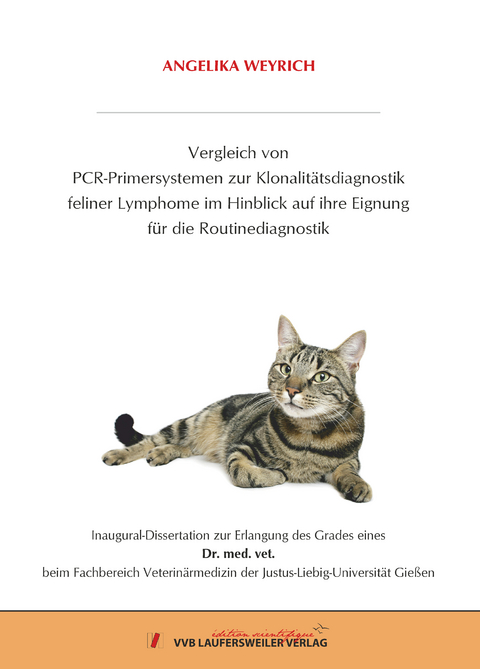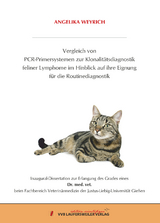Vergleich von PCR-Primersystemen zur Klonalitätsdiagnostik feliner Lymphome im Hinblick auf ihre Eignung für die Routinediagnostik
Seiten
2022
VVB Laufersweiler Verlag
978-3-8359-7074-8 (ISBN)
VVB Laufersweiler Verlag
978-3-8359-7074-8 (ISBN)
- Keine Verlagsinformationen verfügbar
- Artikel merken
1.Ziel dieser Arbeit war es, verschiedene zur PCR-basierten Klonalitätsdiagnostik bei der Katze publizierte Primersysteme an formalinfixiertem und in Paraffin eingebettetem Gewebe (FFPE-Material) feliner Lymphome gegeneinander zu testen und auf ihre Eignung für den Routineeinsatz zu bewerten.
2.In der Literaturübersicht wird zunächst der Aufbau der Antigenrezeptoren und das Rearrangement der Antigenrezeptorgene zur Diversitätssteigerung sowie die genomische Organisation bei der Katze beschrieben. Darüber hinaus wird ein Überblick über die Einteilung feliner Lymphome gegeben. Schließlich werden die gängigen Verfahren zur Diagnose von Lymphomen in Humanmedizin und Veterinärmedizin erläutert, mit besonderem Fokus auf der PCR-basierten Klonalitätsdiagnostik.
3.Zur Ermittlung des für die Routinediagnostik am besten geeigneten Testsystems, wurde DNS von 31 T-Zell- bzw. 29 B-Zell-Lymphomen und 11 nicht neoplastischen Kontrollproben mit den entsprechenden Primersystemen von MOORE et al. (2005), WEISS et al. (2011), MOCHIZUKI et al. (2012) und ROUT et al. (2019) zum Nachweis von T-Zell-Klonalität bzw. von WERNER et al. (2005), HENRICH et al. (2009), MOCHIZUKI et al. (2011) und ROUT et al. (2019) zum Nachweis von B-Zell-Klonalität amplifiziert und anschließend kapillarelektrophoretisch untersucht.
4.Das beste Ergebnis beim Nachweis von T-Zell-Klonalität erbrachte die Kombination der Testsysteme von WEISS et al. (2011) und MOCHIZUKI et al. (2012) (Sensitivität 81 % bei einem 95 % CI von 62,53 % bis 92,55 %, Spezifität 91 % bei einem 95 % CI von 61,52 % bis 99,79 %, positiver prädiktiver Wert 96 % und negativer prädiktiver Wert 62 %, einhundertprozentige Auswertbarkeit). Das beste Ergebnis beim Nachweis von B-Zell-Klonalität erzielte die Kombination der Testsysteme von MOCHIZUKI et al. (2011) und ROUT et al. (2019) ohne die PCR zum Nachweis eines Kde-Rearrangements (Sensitivität 72 % bei einem 95 % CI von 52,76 % bis 87,27 %, Spezifität 64 % bei einem 95 % CI von 30,79 % bis 89,07 %, positiver prädiktiver Wert 84 % und negativer prädiktiver Wert 47 %, einhundertprozentige Auswertbarkeit).
5.Zusammenfassend lässt sich sagen, dass der Einsatz dieser Primersysteme an FFPE-Gewebe aus der Routinediagnostik sinnvoll sein kann. Der gute positive prädiktive Wert in Kombination mit einem nur mäßigen negativen prädiktiven Wert kennzeichnet die PCR-basierte Klonalitätsdiagnostik bei der Katze als Bestätigungstestverfahren, dass seine Hauptanwendung zur Untermauerung der Lymphom-Diagnose bei bereits zuvor bestehendem deutlichem Verdacht findet. Es ist davon abzusehen, ein negatives Testergebnis als Malignitätsausschluss zu werten. 1.The aim of this work was to test different PCR primer sets published for clonality diagnostics in cats against each other on formalin-fixed and paraffin-embedded tissue samples (FFPE material) of feline lymphomas and to evaluate their suitability for routine use.
2.The literature review first describes the structure oft he antigen receptors and the rearrangement oft he antigen receptor genes to increase diversity as well as the genomic organization in the cat. Furthermore, an overview oft he classification of feline lymphosarcoma is given. Finally, the current procedures fort he diagnosis of lymphosarcoma in human and veterinary medicine are explained, with a special focus on PCR-based clonality diagnostics.
3.To determine the most suitable test system for routine diagnostics, DANN from 31 T-cell and 29 B-cell lymphosarcomas and 11 non-neoplastic control samples was tested with the corresponding primer systems from MOORE et al (2005), WEISS et al (2011), MOCHIZUKI et al. (2012) and ROUT et al. (2019) fort he detection of T-cell clonality and of WERNER et al. (2005), HENRICH et al. (2009), MOCHIZUKI et al. (2011) and ROUT et al. (2019) fort he detection of B-cell clonality, respectively, and subsequently analyzed by capillary electrophoresis.
4.The best result in the detection of T-cell clonality was obtained by combining the test systems of WEISS et al. (2011) and MOCHIZUKI et al. (2012) (sensitivity 81% at a 95% CI from 62.53% to 92.55%, specificity 91% at a 95% CI from 61.52% to 99.79%, positive predictive value 96% and negative predictive value 62%, one hundred percent evaluability). The best result fort he detection of B-cell clonality was achieved by combining the test systems of MOCHIZUKI et al (2011) and ROUT et al (2019) without the PCR fort he detection of a Kde rearrangement (sensitivity 72% at a 95% CI from 52.76% to 87.27%, specificity 64% at a 95% CI from 30.79% to 89.07%, positive predictive value 84% and negative predictive value 47%, 100% evaluability).
5.In summary, the use of these primer sets on FFPE tissue from routine diagnostics may be useful. The good positive predictive value in combination with an only moderate negative predictive value characterizes PCR-based clonality diagnostics in cats as a confirmatory test procedure that finds ist main application to substantiate the lymphosarcoma diagnosis in the case of previously existing clear suspicion. A negative test result should not be interpreted as exclusion of malignancy.
2.In der Literaturübersicht wird zunächst der Aufbau der Antigenrezeptoren und das Rearrangement der Antigenrezeptorgene zur Diversitätssteigerung sowie die genomische Organisation bei der Katze beschrieben. Darüber hinaus wird ein Überblick über die Einteilung feliner Lymphome gegeben. Schließlich werden die gängigen Verfahren zur Diagnose von Lymphomen in Humanmedizin und Veterinärmedizin erläutert, mit besonderem Fokus auf der PCR-basierten Klonalitätsdiagnostik.
3.Zur Ermittlung des für die Routinediagnostik am besten geeigneten Testsystems, wurde DNS von 31 T-Zell- bzw. 29 B-Zell-Lymphomen und 11 nicht neoplastischen Kontrollproben mit den entsprechenden Primersystemen von MOORE et al. (2005), WEISS et al. (2011), MOCHIZUKI et al. (2012) und ROUT et al. (2019) zum Nachweis von T-Zell-Klonalität bzw. von WERNER et al. (2005), HENRICH et al. (2009), MOCHIZUKI et al. (2011) und ROUT et al. (2019) zum Nachweis von B-Zell-Klonalität amplifiziert und anschließend kapillarelektrophoretisch untersucht.
4.Das beste Ergebnis beim Nachweis von T-Zell-Klonalität erbrachte die Kombination der Testsysteme von WEISS et al. (2011) und MOCHIZUKI et al. (2012) (Sensitivität 81 % bei einem 95 % CI von 62,53 % bis 92,55 %, Spezifität 91 % bei einem 95 % CI von 61,52 % bis 99,79 %, positiver prädiktiver Wert 96 % und negativer prädiktiver Wert 62 %, einhundertprozentige Auswertbarkeit). Das beste Ergebnis beim Nachweis von B-Zell-Klonalität erzielte die Kombination der Testsysteme von MOCHIZUKI et al. (2011) und ROUT et al. (2019) ohne die PCR zum Nachweis eines Kde-Rearrangements (Sensitivität 72 % bei einem 95 % CI von 52,76 % bis 87,27 %, Spezifität 64 % bei einem 95 % CI von 30,79 % bis 89,07 %, positiver prädiktiver Wert 84 % und negativer prädiktiver Wert 47 %, einhundertprozentige Auswertbarkeit).
5.Zusammenfassend lässt sich sagen, dass der Einsatz dieser Primersysteme an FFPE-Gewebe aus der Routinediagnostik sinnvoll sein kann. Der gute positive prädiktive Wert in Kombination mit einem nur mäßigen negativen prädiktiven Wert kennzeichnet die PCR-basierte Klonalitätsdiagnostik bei der Katze als Bestätigungstestverfahren, dass seine Hauptanwendung zur Untermauerung der Lymphom-Diagnose bei bereits zuvor bestehendem deutlichem Verdacht findet. Es ist davon abzusehen, ein negatives Testergebnis als Malignitätsausschluss zu werten. 1.The aim of this work was to test different PCR primer sets published for clonality diagnostics in cats against each other on formalin-fixed and paraffin-embedded tissue samples (FFPE material) of feline lymphomas and to evaluate their suitability for routine use.
2.The literature review first describes the structure oft he antigen receptors and the rearrangement oft he antigen receptor genes to increase diversity as well as the genomic organization in the cat. Furthermore, an overview oft he classification of feline lymphosarcoma is given. Finally, the current procedures fort he diagnosis of lymphosarcoma in human and veterinary medicine are explained, with a special focus on PCR-based clonality diagnostics.
3.To determine the most suitable test system for routine diagnostics, DANN from 31 T-cell and 29 B-cell lymphosarcomas and 11 non-neoplastic control samples was tested with the corresponding primer systems from MOORE et al (2005), WEISS et al (2011), MOCHIZUKI et al. (2012) and ROUT et al. (2019) fort he detection of T-cell clonality and of WERNER et al. (2005), HENRICH et al. (2009), MOCHIZUKI et al. (2011) and ROUT et al. (2019) fort he detection of B-cell clonality, respectively, and subsequently analyzed by capillary electrophoresis.
4.The best result in the detection of T-cell clonality was obtained by combining the test systems of WEISS et al. (2011) and MOCHIZUKI et al. (2012) (sensitivity 81% at a 95% CI from 62.53% to 92.55%, specificity 91% at a 95% CI from 61.52% to 99.79%, positive predictive value 96% and negative predictive value 62%, one hundred percent evaluability). The best result fort he detection of B-cell clonality was achieved by combining the test systems of MOCHIZUKI et al (2011) and ROUT et al (2019) without the PCR fort he detection of a Kde rearrangement (sensitivity 72% at a 95% CI from 52.76% to 87.27%, specificity 64% at a 95% CI from 30.79% to 89.07%, positive predictive value 84% and negative predictive value 47%, 100% evaluability).
5.In summary, the use of these primer sets on FFPE tissue from routine diagnostics may be useful. The good positive predictive value in combination with an only moderate negative predictive value characterizes PCR-based clonality diagnostics in cats as a confirmatory test procedure that finds ist main application to substantiate the lymphosarcoma diagnosis in the case of previously existing clear suspicion. A negative test result should not be interpreted as exclusion of malignancy.
| Erscheinungsdatum | 06.12.2022 |
|---|---|
| Reihe/Serie | Edition Scientifique |
| Verlagsort | Gießen |
| Sprache | deutsch |
| Maße | 148 x 215 mm |
| Gewicht | 800 g |
| Themenwelt | Veterinärmedizin ► Allgemein |
| Schlagworte | Diagnose • Diagnostik • Katzen • Krebs • Lymphome • PCR |
| ISBN-10 | 3-8359-7074-7 / 3835970747 |
| ISBN-13 | 978-3-8359-7074-8 / 9783835970748 |
| Zustand | Neuware |
| Informationen gemäß Produktsicherheitsverordnung (GPSR) | |
| Haben Sie eine Frage zum Produkt? |
Mehr entdecken
aus dem Bereich
aus dem Bereich
Buch | Softcover (2025)
Mensch & Buch (Verlag)
CHF 69,85


